You’ll need a ceramic-lined crock pot and dedicated stainless steel tools to set up your pickle pot properly. Choose between commercial solutions like Sparex No. 2 or homemade citric acid mixtures, always adding acid to distilled water slowly while wearing safety gear. Maintain your solution at 140°F for ideal oxidation removal, and store it in labeled, non-metal containers in well-ventilated areas. Master these fundamentals and you’ll discover advanced techniques for professional-grade results.
Choosing the Right Pickle Pot Equipment
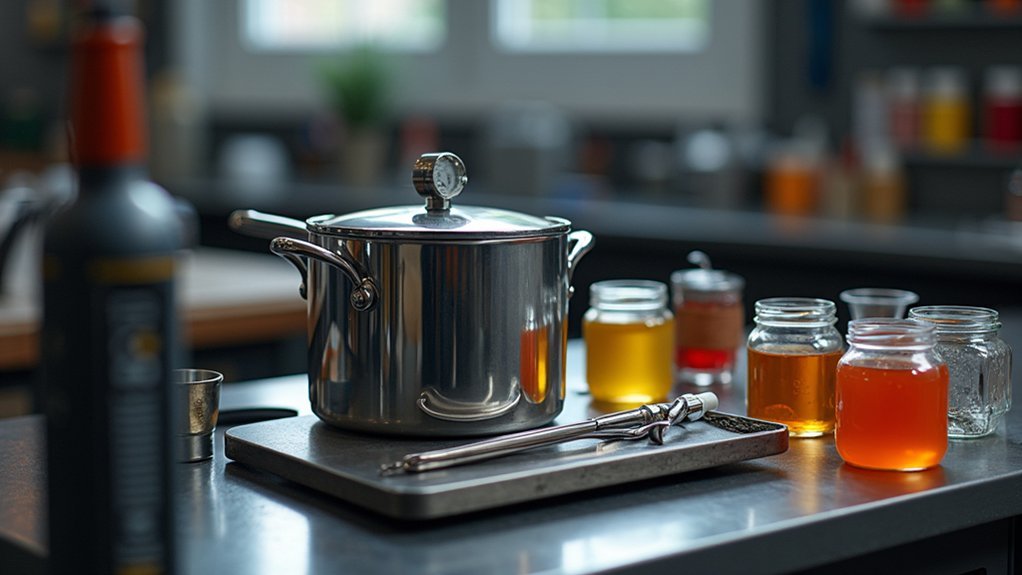
When selecting equipment for your pickle pot setup, you’ll want to prioritize a ceramic-lined crock pot that prevents corrosion and delivers consistent heat distribution.
The most popular sizes are 1.5 and 3 quarts, which accommodate various project scales. Never choose a pickle pot with metal components, as they’ll react with acidic solutions and contaminate your mixture, compromising effectiveness.
Look for models featuring removable ceramic inserts. This design makes cleaning effortless and allows quick solution replacement when needed.
You’ll also need dedicated utensils like stainless steel tongs and spoons. Label these tools “studio use only” to prevent cross-contamination with kitchen items.
Remember to stock distilled water exclusively for mixing your pickle solution—tap water contains impurities that reduce pickling effectiveness.
Understanding Different Types of Pickle Solutions
You’ll need to choose between commercial pickle solutions and homemade recipes, each offering different levels of convenience and cost-effectiveness.
Commercial options provide consistent results and often include safety additives, while homemade solutions like citric acid mixtures give you more control over ingredients and strength.
Understanding the safety requirements and effectiveness of each type will help you select the best solution for your specific metalworking needs.
Commercial Pickle Options
Although numerous pickle solutions exist on the market, understanding their distinct properties will help you choose the right one for your metalworking needs.
When exploring commercial pickle options, Sparex No. 2 stands out as the most popular choice due to its exceptional safety profile and proven effectiveness at removing oxidation from metal projects.
You’ll also find alum-based solutions that work faster when heated, making them efficient for busy workshops.
Black Magic Pickle offers another alternative available through Amazon, though user experiences vary considerably.
While sulfuric acid pickles remain effective with their 5-10% solutions, they’re increasingly rare in modern jewelry practices due to safety concerns.
Each option requires different handling protocols and offers varying performance levels for your specific metalworking applications.
Homemade Pickle Recipes
Four simple homemade pickle recipes can save you money while providing effective oxidation removal for your metalworking projects.
The citric acid pickle offers a non-toxic solution by mixing one part citric acid with six to seven parts distilled water, though it won’t last as long as other options.
You can create a salt and vinegar pickle using one teaspoon of salt per cup of distilled white vinegar for an accessible alternative.
For faster results, try an alum pickle by adding a handful of food-grade alum to water—it’s more effective when warmed.
The alum, vinegar, and salt combination uses one tablespoon of alum with distilled water and eight parts vinegar, creating another reliable homemade pickle recipe.
Safety and Effectiveness
While homemade pickle solutions offer budget-friendly alternatives, understanding the safety profiles and effectiveness levels of different pickle types helps you choose the right solution for your metalworking needs.
Sparex No. 2 leads in both safety and effectiveness, making it ideal for removing oxidation and flux residues without harsh fumes.
Sulfuric acid pickles deliver powerful results but require strict safety precautions due to burn risks and dangerous vapors.
Citric acid provides a non-toxic option, though it has shorter lifespan and potential mold issues.
You’ll enhance any pickle’s effectiveness by heating it in ceramic-lined crock pots, avoiding metal components that corrode.
Always neutralize used solutions with baking soda to prevent environmental contamination.
Proper Mixing Techniques and Safety Protocols
Before you begin mixing your pickle solution, gather all necessary safety equipment and dedicated tools to guarantee a smooth, secure process.
Put on protective gloves, goggles, and a mask to shield yourself from splashes and harmful fumes. Use only distilled water to maintain purity and prevent unwanted chemical reactions with contaminants that might interfere with your pickling results.
Safety gear is essential—protective gloves, goggles, and masks prevent dangerous exposure to acid splashes and toxic fumes during metalwork pickling.
Follow the manufacturer’s specifications carefully when measuring your solution.
Always add the acid to the water slowly, never the reverse, as this prevents dangerous vigorous reactions. Use utensils labeled specifically for studio use to avoid cross-contamination with other materials.
Stir the mixture thoroughly until the powdered acid completely dissolves.
Don’t rush this process—incomplete mixing leads to ineffective pickling and potential damage to your metalwork projects.
Heating and Temperature Management for Optimal Results
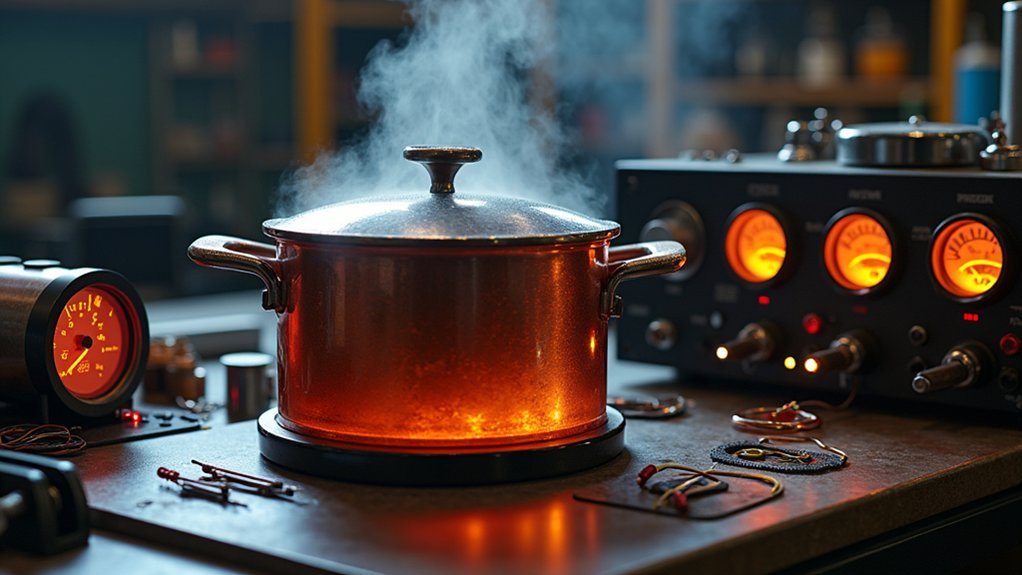
You’ll achieve better cleaning results when your pickle solution operates at warm temperatures rather than room temperature.
Set up a ceramic-lined crockpot in either 1.5 or 3-quart sizes to maintain consistent heat without introducing corrosion risks that metal components would create.
Focus on steady temperature control since fluctuations can affect your solution’s cleaning effectiveness and require longer processing times.
Warm Pickle Works Better
Although cold pickle solutions can remove oxidation, heating your pickle dramatically improves its effectiveness and speeds up the cleaning process. When you warm your pickle solution to the perfect temperature of 140°F (60°C), you’ll notice considerably faster removal of oxidation and flux residues from your metal pieces.
This enhanced cleaning action streamlines your soldering workflow and produces better results.
Use a ceramic-lined crockpot to heat your pickle safely, avoiding the corrosion issues that metal heating containers can cause. Choose one with a removable ceramic insert for easy maintenance and solution replacement.
Monitor your temperature consistently to maintain that ideal 140°F range. You’ll also need to check your pickle’s acidity level regularly to guarantee peak performance and extend your solution’s lifespan.
Ceramic Crockpot Setup
Setting up your ceramic crockpot requires selecting the right size and features for your pickling needs. Choose between 1.5-quart and 3-quart models, which provide sufficient space for effective pickling without excessive evaporation.
The ceramic lining prevents corrosion and enhances durability compared to metal pots, making it vital for long-term use.
Set your ceramic crockpot to maintain proper temperature for ideal pickle solution effectiveness. Warm solutions work considerably better than cold ones, so make certain of consistent heating throughout your pickling process.
Always turn off the unit when not in use to prevent overheating and conserve energy.
If your solution becomes slow or ineffective, gradually add more acid or distilled water to restore potency. Mix thoroughly after each addition to guarantee proper distribution and maintain solution integrity for successful soldering preparation.
Temperature Control Maintenance
When maintaining ideal temperature control, guarantee your pickle solution stays between 140°F and 180°F for maximum cleaning effectiveness.
You’ll need to regularly monitor your pickle’s temperature during use since overheating can diminish its effectiveness and alter the chemical balance. Your ceramic-lined crock pot prevents metal corrosion that would contaminate the solution.
When you’re adding distilled water to your heated pickle pot, do it slowly to avoid drastic temperature changes that compromise the solution’s integrity.
Temperature control becomes essential here because rapid fluctuations can damage your pickle’s chemical composition.
After adding water, you’ll need to test the pickle’s effectiveness since it may take several hours to reabsorb acid and regain its full cleaning capabilities.
Safe Handling and Storage Practices
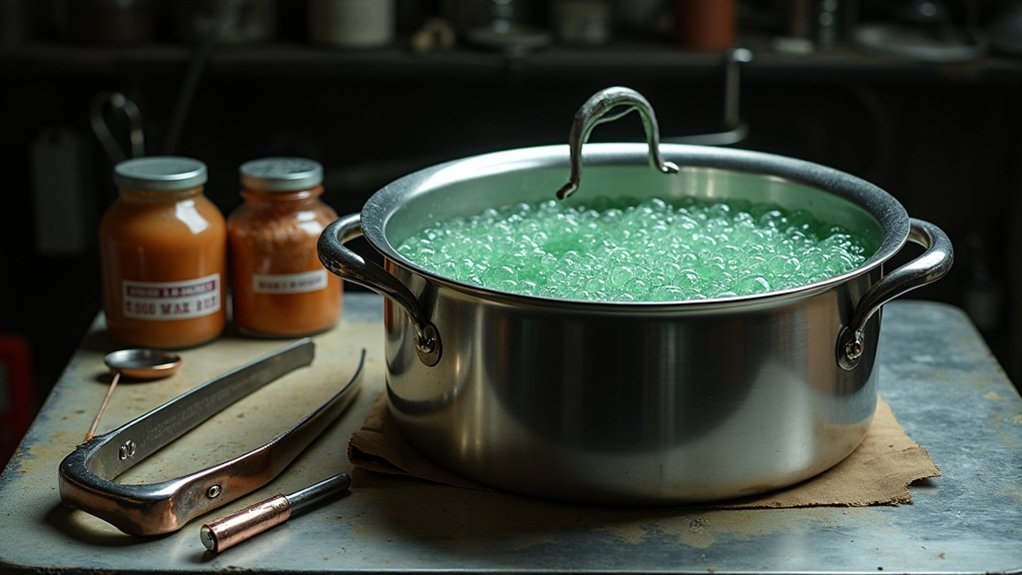
Since pickle solutions contain corrosive acids that can cause severe burns and emit harmful vapors, you’ll need to prioritize safety from the moment you begin working with them.
Safe handling requires consistent protective measures every time you use your pickle pot.
Essential safety protocols include:
- Personal Protection – Always wear safety goggles, gloves, and a mask to shield yourself from splashes and corrosive fumes that can damage skin and respiratory systems.
- Proper Storage – Store solutions in clearly labeled, non-metal containers and keep your pickle pot in well-ventilated areas to minimize vapor exposure.
- Contamination Prevention – Designate specific tools exclusively for pickle use and store them separately from food items to prevent dangerous cross-contamination.
Before disposal, neutralize solutions with baking soda to prevent environmental hazards.
Maintenance and Solution Longevity Tips
Proper maintenance keeps your pickle solution working efficiently and extends its useful life considerably.
Regular maintenance of your pickle solution ensures optimal performance and significantly extends its working lifespan.
You’ll need to regularly add distilled water to replace what’s lost through evaporation, maintaining the solution’s proper concentration. Strain your pickle solution periodically to remove accumulated dirt and metal particles that can reduce its effectiveness.
Watch for visual cues that indicate when changes are needed. If your pickle solution turns turquoise green, copper contamination has occurred and you should replace it entirely.
Similarly, when the solution becomes visibly dirty or saturated with metals, it’s time for a fresh batch.
Always store your pickle solution in a clearly labeled container to prevent accidents and guarantee safe handling of this acidic material.
Neutralization and Environmental Disposal Methods
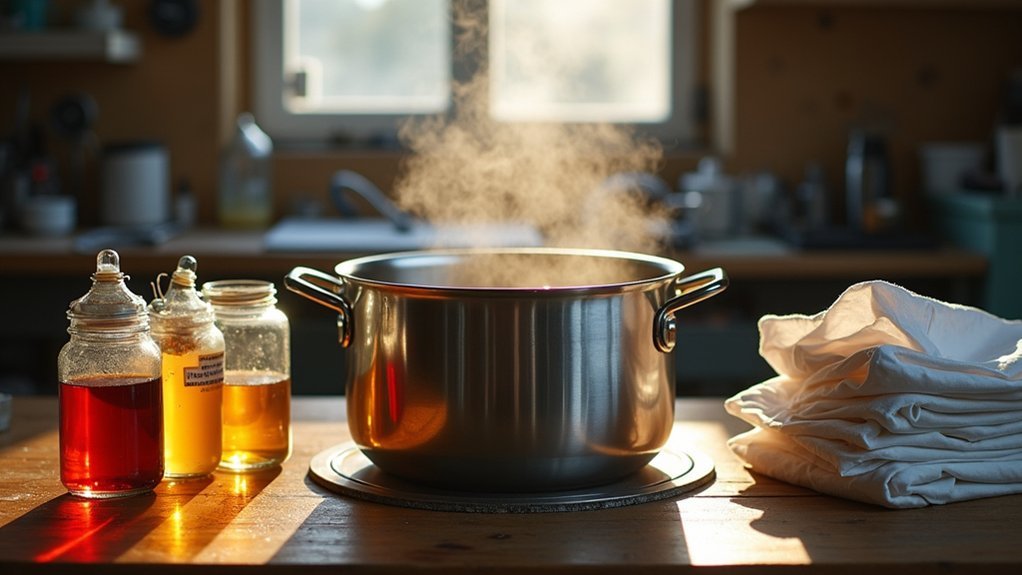
Once your pickle solution has completed its cleaning work, you’ll need to neutralize it before disposal to prevent ongoing corrosion and environmental damage.
Create a neutralization mixture using baking soda and water in a large container to prevent overflow. You’ll see bubbles forming when the process works effectively.
Follow these essential steps for safe disposal:
- Filter the neutralized solution using a funnel and Melitta filter to remove waste products before disposal.
- Store in clearly labeled containers to prevent hazardous exposures and guarantee safe studio handling.
- Avoid drains and natural water sources as copper-saturated water harms aquatic life and septic system bacteria.
Proper neutralization protects both your workspace and the environment from copper contamination.
Frequently Asked Questions
How to Set up a Pickle Pot?
You’ll need a ceramic-lined crock pot, distilled water, and sodium bisulfate. Mix the solution carefully, place in ventilated area, warm it up, and label your tools for safety.
Do You Pickle Before or After Soldering?
You’ll pickle after soldering to remove flux residues and oxidation that formed during heating. Clean your pieces thoroughly before soldering first, then immediately pickle afterward to maintain metal quality and joint integrity.
How Do You Make Pickling Solution for Soldering?
You’ll mix 1 part citric acid with 6-7 parts distilled water for an effective solution. Alternatively, add 1 teaspoon salt per cup of distilled white vinegar, or dissolve food-grade alum in warm water.
How Long to Leave Jewelry in a Pickle Pot?
You’ll typically leave jewelry in pickle for 10-15 minutes to remove oxidation and flux residues. Fine silver and gold need less time than copper or brass. Monitor closely to prevent overexposure damage.
In Summary
You’ve now got the knowledge to set up and maintain your pickle pot safely and effectively. Remember to always prioritize safety with proper ventilation and protective gear. Keep your solutions fresh, monitor temperatures carefully, and dispose of spent pickle responsibly. With these fundamentals mastered, you’ll achieve consistent cleaning results and extend your equipment’s lifespan. Your soldering projects will benefit from the professional-quality surface preparation that only a well-managed pickle pot can provide.

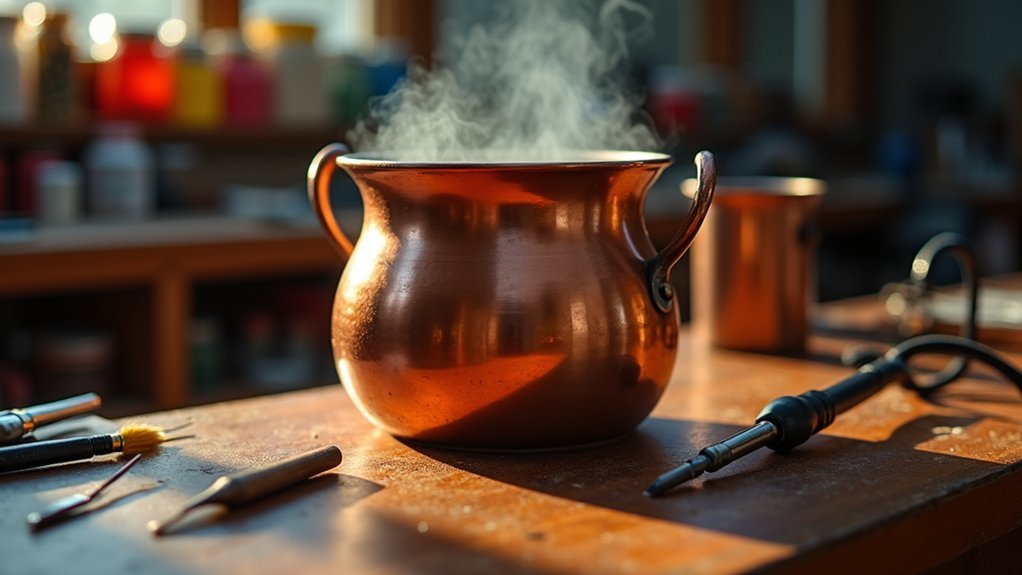
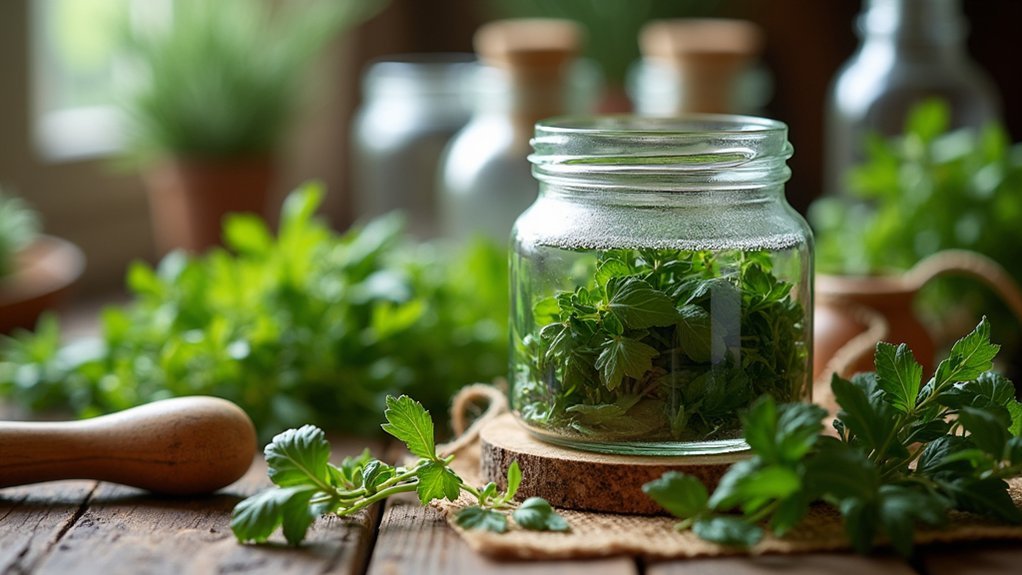
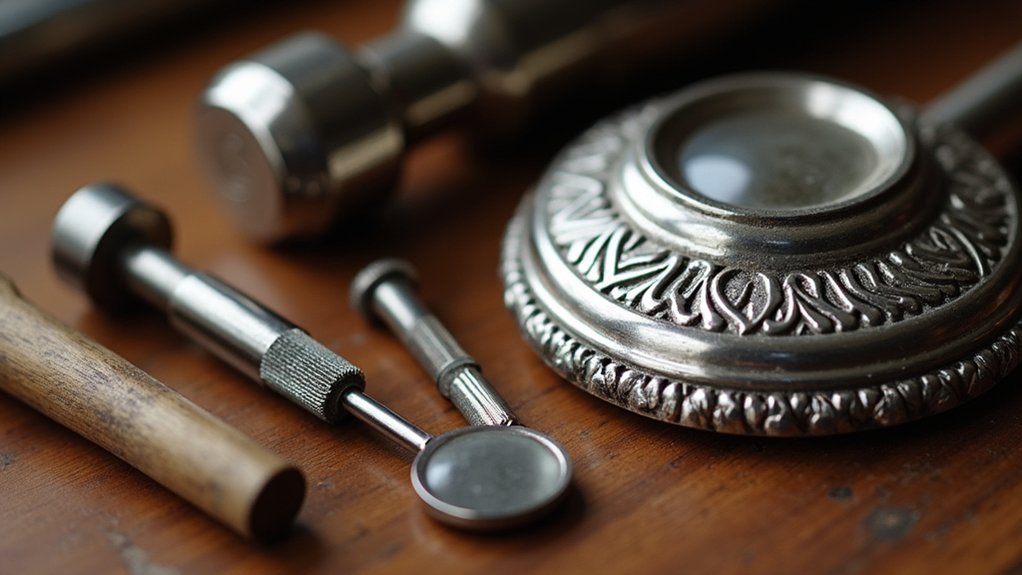
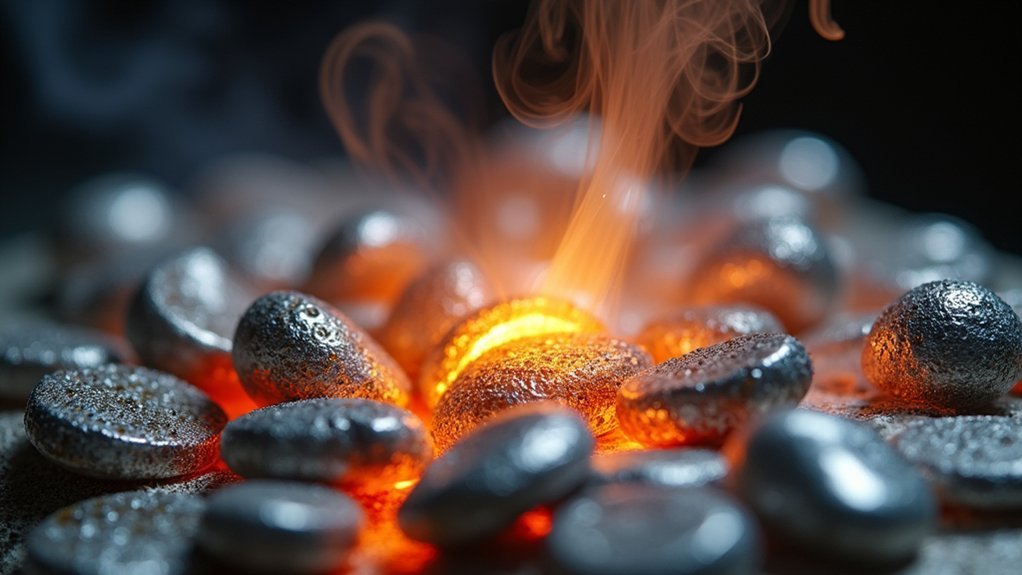
Leave a Reply